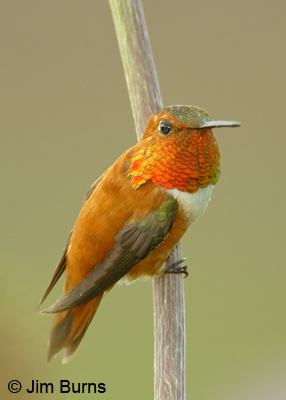
The Birds Of North America characterizes the Rufous as “North America’s extremist hummingbird.” Of course passing by at the speed of hummingbird flight, every other North American hummer except the Rufous male just looks green, but there are other ways the “copper bullet” qualifies as extreme: it is our northernmost hummingbird breeder, summering into Alaska; it flies the longest (measured in body lengths) known avian migration route; it is our most aggressive hummingbird; it has the shortest wings and the highest wing loading of all our hummers.
These four characteristics are, of course, interrelated. High wing loading allows for fast migration flight, necessitated in turn by the longer journey. These long migratory routes are thought to be the reason for the Rufous’s highly aggressive nature. Because of the short breeding season at its northern nesting latitudes, Rufous males are extremely territorial “at home,” and this aggressiveness carries over to migration fuel stops at feeders and flower patches, typically seven to ten day layovers. Since this species has to go farther and faster than everyone else, it has evolved to more aggressively defend its food sources along the way from more passive shorter distance migrants and residents.
In early August we spent a weekend with friends who have a home high above the Blue River in the White Mountains. We arrived late in the day and were sitting outside on the deck, awed by the overview of the Blue and the play of sunlight and shadow as lingering monsoon clouds danced with the surrounding peaks. Their hummingbird feeder, hanging at the corner of the deck, was like the local bar scene on Ladies’ Night—lots of Broad-tailed females, both adults and hatch year birds flitting about, hovering, sitting and drinking, and even one Calliope, evident by her smaller size and tail pattern.
There was not a Broad-tailed male in the bunch, but suddenly we heard that wing whine, higher and more monotone than that of a male Broad-tailed, and a copper bullet shot down the length of the balcony, stopped on a dime in front of the feeder, tipped up vertically, and hovered there as all the females scattered into the forest. Sure enough this was his territory. He took a quick sip, then flew into the closest juniper. From there, from then until dark, every time a female reconnoitered, the male Rufous immediately flushed her off without allowing her to linger and drink. Alright, not really like the local bar scene, but totally typical behavior for our extremist and arguably most interesting and beautiful North American hummingbird. Spend a day at any wildflower patch in Arizona’s high country from mid-July to mid-September and you’ll agree with this argument.